Chef's Knives
Best Damascus Steel Kitchen Knives
Find the Best Damascus Steel Chef Knives for Home Kitchen: If you’re holding on to old, dull knives because they feel safer, get rid of them immediately! Dull knives are dangerous because food can roll around awkwardly under the blade, making it difficult to do simple slicing and dicing.
How to buy a right knife for your kitchen? There are lots of different types of knives to choose from, which can make the selection process rather tricky. The best chef knives come in a wide range of different shapes, styles, and sizes. So, let’s take a look at some of the best chef knives currently available and find the perfect one for you… First, let’s learn something about kitchen knives.
Parts of a Knife
Understanding the parts of a knife is integral to learning about the various types of kitchen knives and how they’re different. The graphic below shows the parts of a knife to help you identify them on your own kitchen knives.
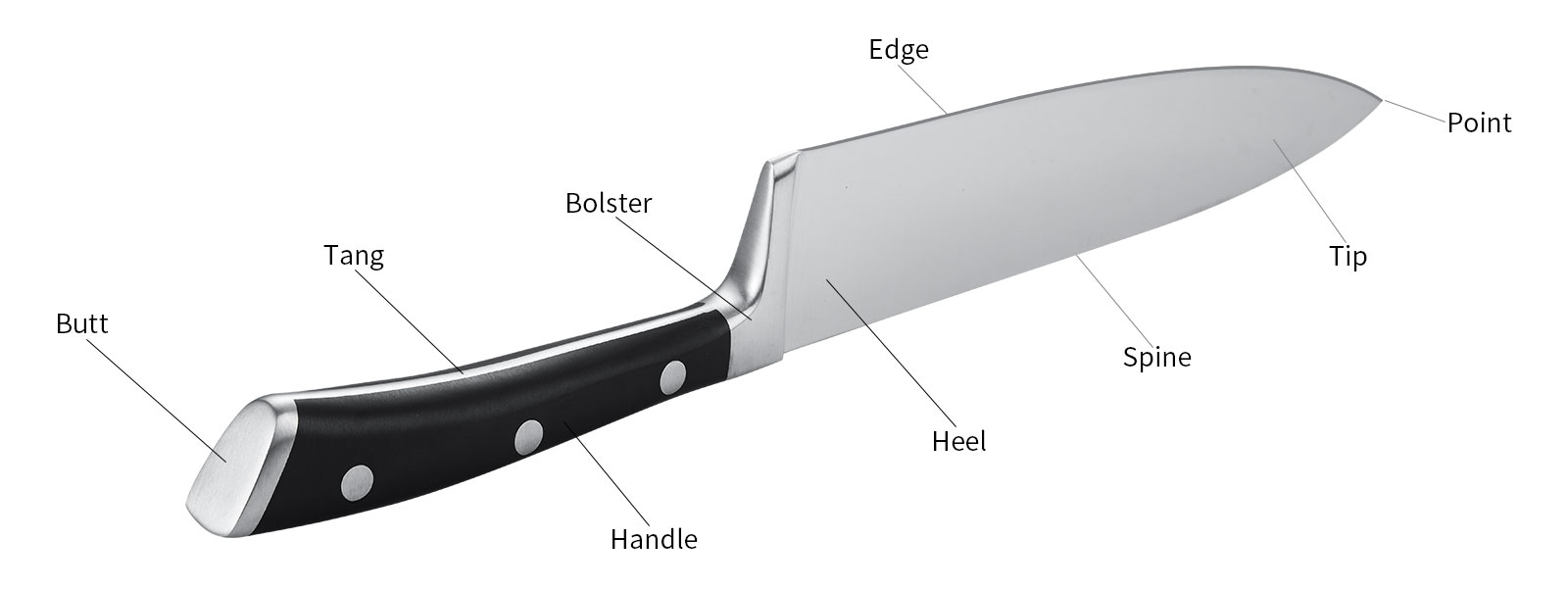
Here’s an explanation of the different parts of a knife:
- Bolster: The bolder is only found on forged knives. It is a thick band of steel between the heel and the handle that helps balance the weight of the knife and prevents the user’s hand from slipping.
- Butt: The butt is the end of the knife’s handle.
- Edge: The edge is the sharpened side of the knife’s blade that you use to cut. Keeping your knife’s edge sharp prevents accidents while cutting.
- Handle: The handle is the section where the user holds the knife. This part of the knife may also be referred to as the scales.
- Heel: The heel is the rear portion of the blade, and it’s most often used for cutting tasks that require a lot of force, such as cutting meat or dense vegetables.
- Point: The point is the tip of the knife. It is often used for piercing through products.
- Spine: This is the unsharpened side of the knife blade that is opposite the edge.
- Tang: The tang is the part of the blade that extends into the handle to provide balance. Full tang blades are considered superior in balance and durability. A sub tang or half tang knife is less durable but more economical.
- Tip: The tip is the front quarter of the blade that does most of the cutting and separating. Point tips are ideal for piercing and cutting small portions whereas rounded tips are ideal for cutting or slicing thin portions.
Common Kitchen Knives Steels
Stainless Steel
Chemically speaking, stainless-steel is a carbon metal with a bit chromium, nickel, and molybdenum brought to help prevent rust. In sensible terms, its far lots extra forgiving in relation to moisture and corrosive meals.
The predominant disadvantage is that its miles slightly weaker than maximum different steels, meaning it is able to want to be sharpened a chunk extra frequently. For maximum cooks, it’s still a net tremendous, and could treat you well.
Do notice, it’s not impervious to oxidation. If you depart acidic materials and moisture on stainless steel, it’ll still broaden rust spots — they simply take longer to form.
High-Carbon Stainless Steel
Most if now not all of the gadgets in our advocated list of the fine kitchen knives are made with high-carbon stainless-steel. As you may guess from the name, this fabric is a try to marry the satisfactory blessings of simple carbon metallic with those of stainless steel. The effectiveness of manufacturers’ excessive-carbon formulation vary and are debated from chef to chef. Some swear via them even as others say they’re simply expensive gimmicks.
Damascus Steel
Different kinds of metal are clad and forged to create distinctive patterns on the steel material. Its greatest feature is the unique ripple-like pattern that appears on the surface when polished, making it a classic example of a high-end culinary knife.
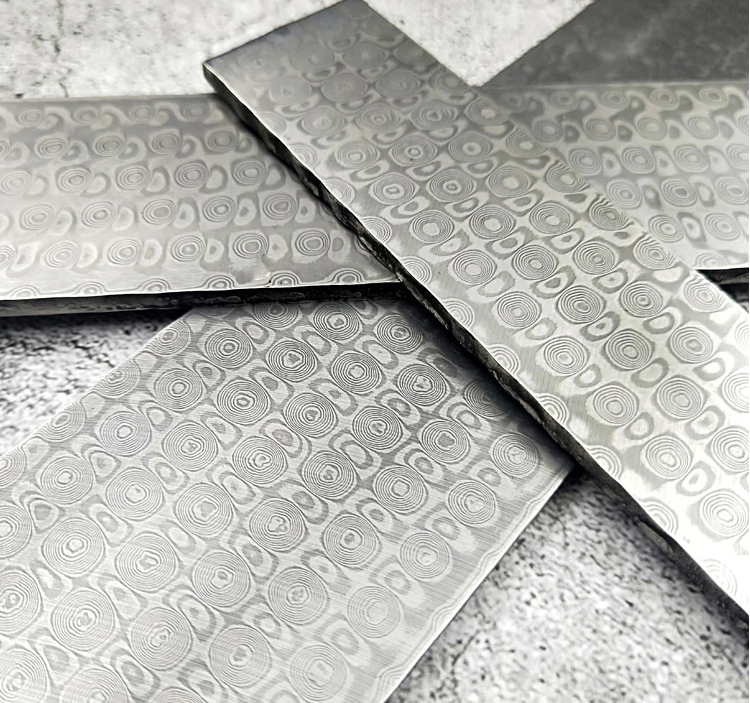
1.Multi-layer Damascus Steel with Japanese VG10 Core
Vg-10 damascus steel knife is one of the knife class defined by the material and structure of the blade.
V Gold 10, a high quality cutting stainless steel, is made from highly-selected pure iron material and is worked by best technology, thus VG10 has ductility and shows workability and forgeability. Besides VG10 is free from corrosion caused by impure substances and achieves good abrasion resistance. Our V Steel Series boast these excellent features.
V Gold10 is a highly alloyed stainless cutlery steel, originally developed by Takefu Special Steels over 60 years ago to make the most of quality raw materials and the alloying effects of various element to make an all-round, high performance blade steel. The addition of 15% of Cr, 1% of Mo and 1,5% of Co makes the matrix (substrate) stronger and prevents carbides from dropping out. By adding V, the structure becomes finer. Combined Cr, Mo, and V form a lot of hard carbides, so abrasion resistance improves which gives knives long-term clean cutting, VG10 is rather machinable and easy to grind.
VG10 also has a quadratic effect in high-temperature tempering which makes it ideal to use in cutting tools which are given surface-coating at up to about 450°C.
| Steel | C | Cr | Mo | V | Co | Hardness |
|---|---|---|---|---|---|---|
| VG10 | 0.95-1.05 | 14.50-15.50 | 0.80-1.20 | 0.25-0.35 | 1.30-1.80 | HRC60 |
2.German X50Cr15MoV steel (420MoV 1.4116 X50CrMoV15 )
X50CrMoV15 is a high hardness martensitic stainless steel. In strip form, its dominant use is for high quality knife blades. This is a rare, possibly a unique, example of the EN Name of a stainless steel grade being used for marketing purposes.
Approximate Composition – 15% Cr, 0.7% Mo, 0.15% V, 0.50% C (EN composition range. No ASTM equivalent).
This grade combines the following characteristics:
Very high hardness – Up to 56 Rockwell C
Retention of blade sharpness
Moderate corrosion resistance better than standard 12% martensitic grades
Poor weldability
X50CrMoV15 uses the moderately high carbon content of 0.50% to develop a high hardness martensitic microstructure. The higher chromium plus small molybdenum addition gives a greater corrosion resistance than standard martensitic grades. Vanadium allows higher tempering temperatures to be used and gives greater toughness.
3. 440C Stainless Steel
440C is a highly corrosion-resistant tool steel. It has a long and proven history of being reliable in many applications other than for fine, handcrafted knife blades.

And is the highest carbon content from 400 stainless steel series. It is usually heat treated to reach hardness of 58–60 HRC. It is a bearing steel, and used in rolling contact stainless bearings, e.g. ball and roller bearings. It is also used to make knife blades. 440C can be oil quenched to achieve maximum hardness.
440C has the highest strength, hardness, and wear resistance of all the commonplace 440-series stainless alloys with high carbon content and moderate corrosion resistance.
Composition:
- Carbon (C) content of 0.95–1.20%
- Chromium (Cr) content of 16.00–18.00%
- Molybdenum (Mo) content of 0.75%
- Manganese (Mn) content of 1.0%
- Silicon (Si) content of 1.0%
4. AUS-6 / AUS-8 / AUS-10 (also 6A / 8A / 10A) Stainless Steel
These grades of Japanese stainless are comparable to 440A (AUS-6), 440B (AUS-8), and 44C (AUS-10). AUS-6 is softer but tougher than ATS-34. It holds a good edge and is fairly easy to resharpen. AUS-8 is tougher but is still easy to sharpen and holds a good edge. AUS-10 has a similar carbon content to 440C, but less chromium, which results in less stain resistance. Unlike the 440 grades, however, all three AUS grades have vanadium alloyed to increase wear resistance and edge retention.
5. R2/SG2: SG-2 is a powdered stainless steel that is well known for excellent wear resistance and is considered a great steel for high end, high quality kitchen knives.
Made up of Carbon: 1.25 – 1.45%,
Vanadium: 1.80 – 2.20%,
Chromium: 14.00 – 16.00%,
Molybdenum: 2.30 – 3.30%,
Manganese: .40%,
Phosphorus: .03%,
Sulfur: .03%,
Silicon: .50%
This is Takefu Specialty Steel’s PM (powdered metallurgy) steel. High-carbon high alloy content stainless steel that has been powderized into a very fine grain and then sintered back together. This process allows for a very consistent gran structure in the steel which makes the blade easier to sharpen and very durable. The steel does not rust and will work great in fast paced kitchen environments. Has a 64HRC.
Damascus Kitchen Knives
A chef knife is a large kitchen knife, usually about eight to ten inches long. Its blade curves upward to a narrow point. It is used in a variety of ways in the kitchen, including chopping, slicing, and dicing. It’s not just for professional chefs, though, as it is recommended for even the casual home cook.
Some of the best Damascus chef knives include:
1.ZWILLING KRAMER – EUROLINE DAMASCUS COLLECTION
8-INCH CHEF’S KNIFE
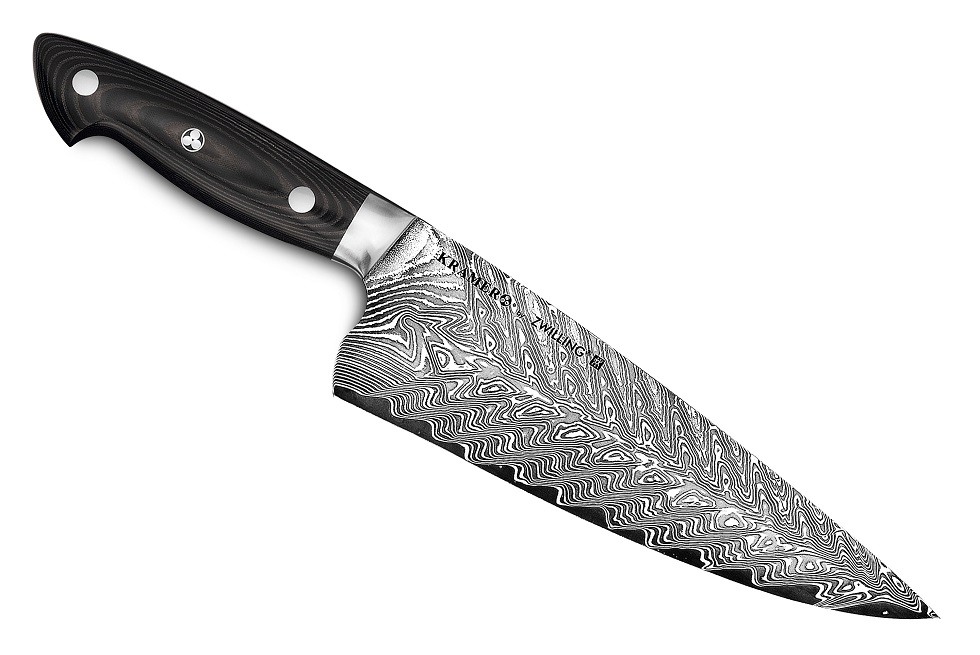
Created with Master Bladesmith Bob Kramer, the KRAMER by ZWILLING EUROLINE Stainless Steel Damascus Collection features stainless steel blades made to his exacting standards, maximizing curves, balance and utility.Bob’s design has an extremely wide blade to maximize knuckle clearance for larger hands and for cutting through large produce and piles of food. Chopped food can easily be transported with this impressive, broad blade.The knives are hand-finished with a traditional 3-step process by skilled Japanese artisans. Combined with the SG2 micro-carbide powder steel, the ice-hardened CRYODUR blades deliver scalpel-like sharpness, stay sharper longer and can withstand more sharpening over their lifespan. The SG2 super steel core is protected by an exceptionally beautiful 100-layer Chevron Damascus pattern, which is complimented by a stunning black linen Micarta handle and signature Bob Kramer mosaic pin.
- SG2 (MC63) micro-carbide powder steel
- Designed to Master Bladesmith Bob Kramer’s exacting specifications, made in Japan
- Traditional 3-step hand sharpening for exceptionally high sharpness
- Double-tapered blade and tang
- Beautiful 101-layer Chevron Damascus design
- Riveted black linen Micarta handle with Bob Kramer mosaic pin will not crack or discolor
- 63 Rockwell Hardness = exceptional edge retention
- Edge angle 9-12 degrees on each side
2. SHUN Sora Chef’s 8″
This is the place to start your Shun Sora collection. In Japan, the Sora Chef’s Knife would be called a gyuto. It’s used for all the same purposes as a chef’s knife—all-around food preparation. But it has slightly less curve than a Western chef’s knife, which means it contacts the cutting board along more of its length, so more food is cut per slice.

The Sora has a gentle roll off the tip compared to the large roll of a Western style knife, so the Sora needs to be lifted less, making cutting more efficient.
- THE must-have kitchen knife
- Proprietary Composite Blade Technology puts high-performance VG10 steel on the cutting edge and highly corrosion-resistant Japanese 420J stainless steel on the blade upper
- San mai edge construction protects and supports the VG10 cutting core; razor-sharp 16° edge for quick, easy cutting
- Traditional handle design in textured PP/TPE polymer blend provides a contemporary look, secure grip and balance, and is easy to maintain
- Blade tang extends all the way to the embossed handle medallion for strength and balance
- Handcrafted in Japan
3.Shogun Series X 8″ Damascus Chef Knife
The Dalstrong Shogun Series X 8” AUS-10V chef knife with a beautiful tsuchime finish. Supreme function meets stunning elegance. Put a lion in your hands! This is the flag bearer of the Shogun Series, and the most indispensable of all kitchen blades. This chef knife is a master of versatility and with exceptional cutting prowess. The Shogun Series of knives are what careers are built on. Painstakingly crafted over 60 days using the highest quality materials, it is both a razor-sharp kitchen powerhouse and artistic statement in premium design and workmanship.
The Shogun Series X 55mm wide blade is precision forged from a single piece of 66-layered damascus high-carbon stainless steel cladding, with an ultra premium Japanese AUS-10V steel cutting core. Precise cryogenic tempering with liquid nitrogen increases the steel’s crystalline structure, enhancing strength, flexibility and hardness. The increased blade width allows for improved knuckle clearance.
The exquisite hammered tsuchime finish is not only a beautiful statement in craftsmanship, it also serves the purpose of reducing drag and minimizing stuck on food.
Hand-polishing reveals a magnificent visual pattern, Dalstrong’s‘Tsunami Rose’. The super-steel core possesses extra high carbon levels, allowing for scalpel-like sharpness with exceptionally long lasting edge retention. Each knife is hand-finished in the Honbazuke 3-step method, creating a beautiful mirror polished edge at a staggeringly acute 10 degrees per side.
Beautifully engraved into the blade near the bolster is the Dalstrong lionhead logo for further refinement.
The Shogun Series X handle is meticulously constructed of G-10 Garolite, an incredibly strong military-grade inert and non-porous fiberglass-like material. It is highly impervious to both heat and moisture with life-long durability. The carefully engineered ergonomic handle is designed for superior hand control and comfort. while simultaneously being stabilized with an engraved end-cap for agile performance. To further enhance the beauty, an intricate copper mosaic pin adorns the center rivet.
A premium -quality polymer Dalstrong PerfectFit saya (sheath) with embossed Dalstrong logo and pin is included with the set to ensure your blade is carefully protected.
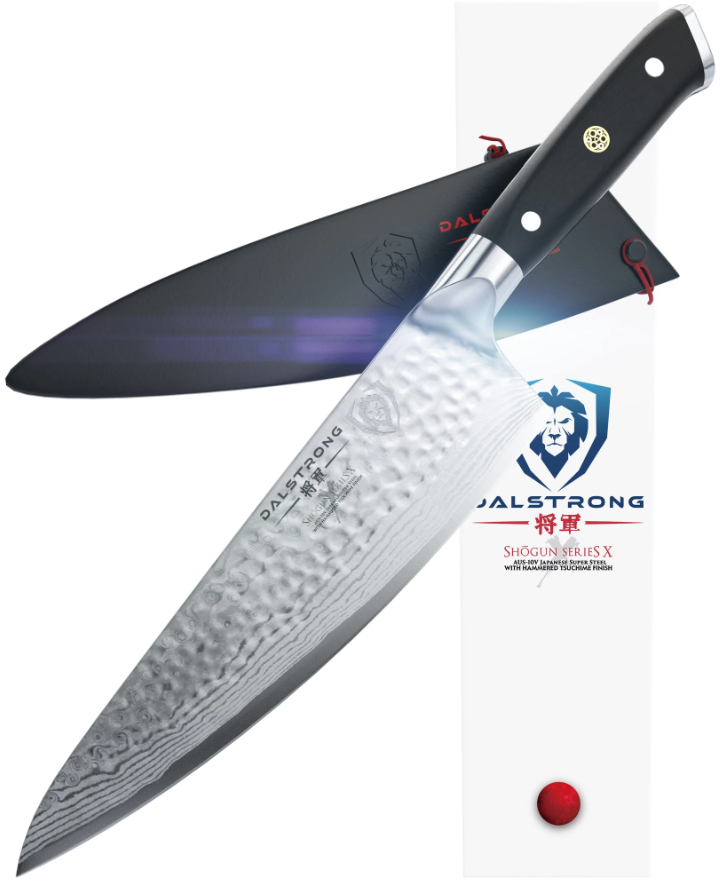
The Blade
8” precision forged blade with an ultra-premium Japanese AUS-10V ‘super steel’ cutting core at 62+ Rockwell hardness for unrivaled performance and incredible edge retention.
66-layers of high-carbon stainless steel cladding provides exceptional strength, durability and stain resistance.
Ruthlessly sharp scalpel like edge is hand finished to a mirror polish within a staggering 8-12° degree angle per side using the traditional 3-step Honbazuke method.
Nitrogen cooled for enhanced hardness, flexibility and corrosion resistance
Featuring Dalstrong’s exquisite Shogun Series Tsunami Rose blade pattern, for striking, stand out beauty.
Dalstrong lion head logo engraved for additional refinement
Precisely tapered blade minimizes surface resistance for buttery smooth cut through.
Mirror polished bolster provides a perfectly engineered balance and gently encourages a comfortable and proper pinch grip
Blade’s spine is hand polished to a smooth finish for enhanced pinch grip comfort
Wide blade height for improved knuckle clearance and ability to scoop and transfer food.
Shogun Series X beautiful hammered tsuchime finish reduces drag and creates tiny air pockets which minimize stuck on food.
The Handle
Meticulously constructed ultra-premium G-10 Garolite handle. Highly impervious to heat, cold and moisture with military grade strength and life-long durability.
Carefully hand polished
Ergonomic handle shape for superior hand control, agility and comfort
Beautifully crafted copper mosaic pin adorns the center rivet for added distinction
Triple riveted for even more resilience
Full tang for superb robustness & quality
Stainless steel end cap (second bolster) adds perfect counter balance, with an additional Dalstrong logo engraved.
3. SEISUKE 17 Layer Damascus Hammered Japanese Chef Kitchen Knife 240mm
Kenshin is Japanny’s original brand. In addition to the combination of various splendid Japanese knife craftsmen, the beauty of Japanese traditional culture makes it to the unique product which you will never find anywhere. Like any other popular brands, Keshin offers numerous knives consist of variety of blade type and length. It suits from professional culinary to home use.
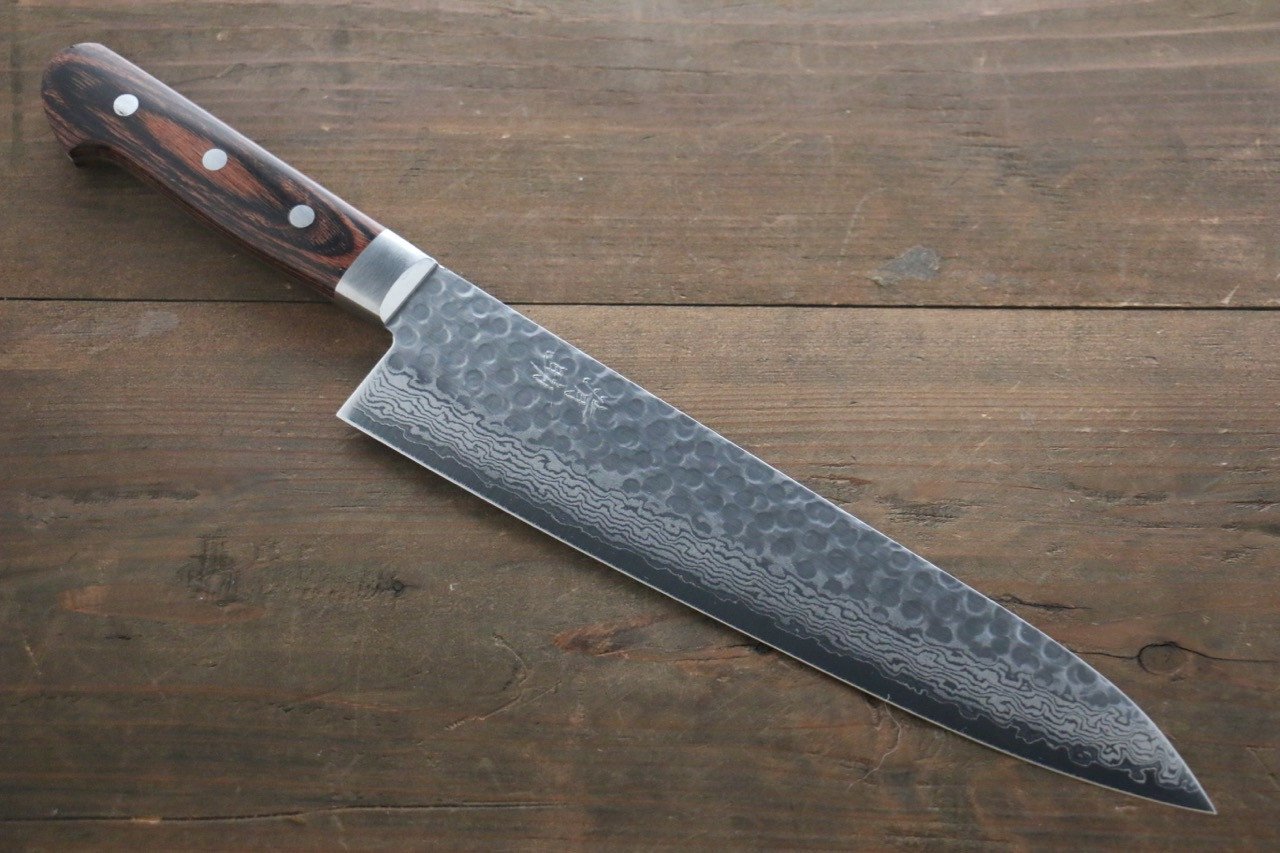
The 17-layer Damascus steel used in making this razor sharp Japanese knife is hand hammered to ensure the strength of the blade and at its core is one of the best steels used in kitchen knife production due to its superior edge retention, sharpness, and being stain resistant – the VG10 steel.
Specifications
Knife Type: Gyuto Chef Knife
Steel Type: VG10 (Stain Resistant) Damascus
Blade Type: Double edged blade
Blade Length: 240mm
Blade Height: 48mm
Blade Thickness: 2.0mm
Handle Length: 127mm
Weight: 282g
Use & Care
– Do not attempt to cut, hit or chop frozen products or bones. The blade can chip or break.
– Hand wash with warm water and towel dry.
– Use a sharpening stone to maintain the sharpness of blade.
4. Wüsthof Classic Ikon 8″ Cook’s Knife – 4596-7/20

Key Features:
- Precision-forged from a single blank of high carbon stainless steel
- Full tang that is triple riveted to the handle for precise control
- Precision Edge Technology (PEtec) yields a blade that is 20% sharper with twice the edge retention.
- The half bolster allows for the knife to be honed and sharpened the entire length of the blade and the heel bolster provides added balance
- Contoured handle for comfortable fit and a more contemporary appearance
CLASSIC IKON knives feature a distinctive, double bolster design for professional-style heft, exceptional balance and beauty. The handle is made of a highly durable synthetic material – Polyoxymethylene (POM) – which has a tighter molecular structure to resist fading and discoloration. The elegant shape of the handle is designed for a comfortable grip.
The best chef knives are designed to last for many years, even with regular use. Therefore, it is important to take the time to choose a model that you are truly satisfied with. Here are some of the key factors that you should look for when shopping for the perfect chef knife.
Conclusion:
Generally speaking, the best chef knives are either German or Japanese. Both of these knives have distinctive styles that are designed for different types of tasks. German knives tend to be heavier and thicker, which also makes them slightly more durable.
The Blade
You will want to choose a blade that is as strong and durable as possible while also being resistant to corrosion. The most common options are stainless steel, carbon steel, Damascus, and ceramic. Stainless steel blades are known for being especially durable, although they need to be sharpened regularly.
The fact that carbon steel blades retain their edge well makes them a popular choice among professional chefs. Both ceramic blades and Damascus blades are known for staying sharp. One of the great things about these blades is that they are not as costly as blades made of carbon steel.
The Handle
The handle can be made of a wide range of different types of materials, such as resin, wood, and plastic. Whichever model you choose, you will need to make sure that it is especially sturdy. The handle should fit comfortably in your hand and allow you to get a good grip while you are slicing and dicing.
The Balance
The knife should be well balanced so that you are provided with good control. This means that the handle and the blade should boast roughly the same weight. If the handle is too light, you may find that wielding the blade is rather tricky.
Staying Sharp
While most knives come with a sharp blade, some retain their edge better than others. This is generally dictated by the way the knife blade is forged and the materials it is made from. For the best results, it is a good idea to choose a blade that retains its edge well.
Notes:
How many layers should Damascus steel have? does it matter?
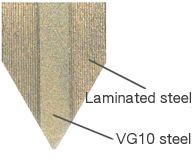
(1). VG10 Damascus steel blade; VG-10 cutting edge is sandwiched between layers of different steel. The number of layers just affects how fine the lines are and how many show on the blade and has nothing to do with performance. It sure makes a knife look pretty though!
(2). Full VG10 steel blade.
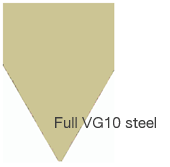
Because they have same cutting core, two blades’ performance will be same. The steel is the key factor that determine knife’s sharpness and prices.


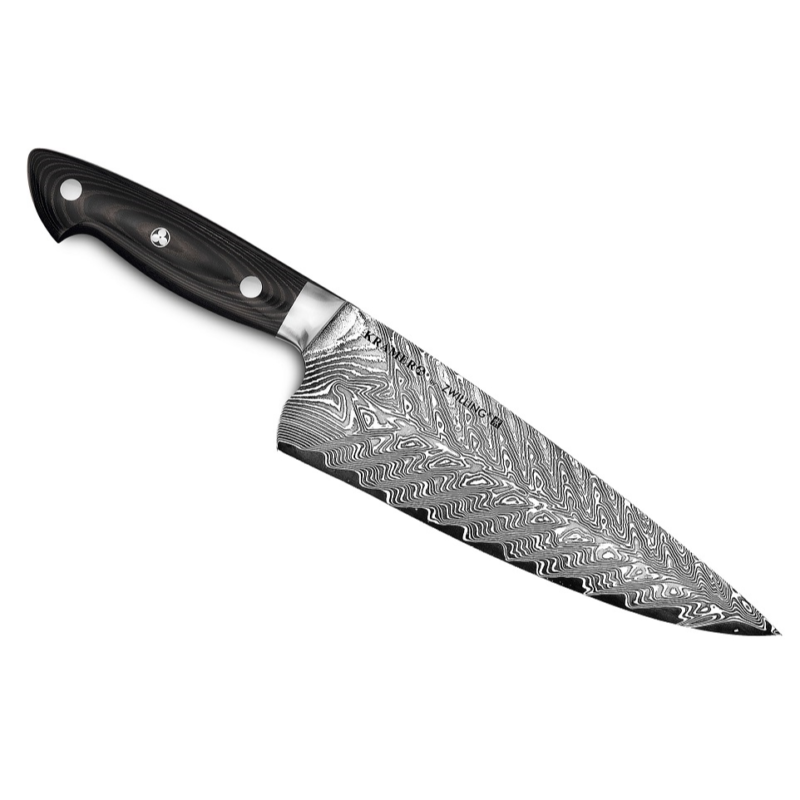
Just a bit confused. Are Damascus steel kitchen knives really worth it?
If you like the way a Damascus blade looks, it can be worth it. If you like a certain manufacturer and their high-end knives are damascus-clad, it can make sense to get those instead of their cheaper lines.
Beautiful knives.
Great page. Very educational and interesting.